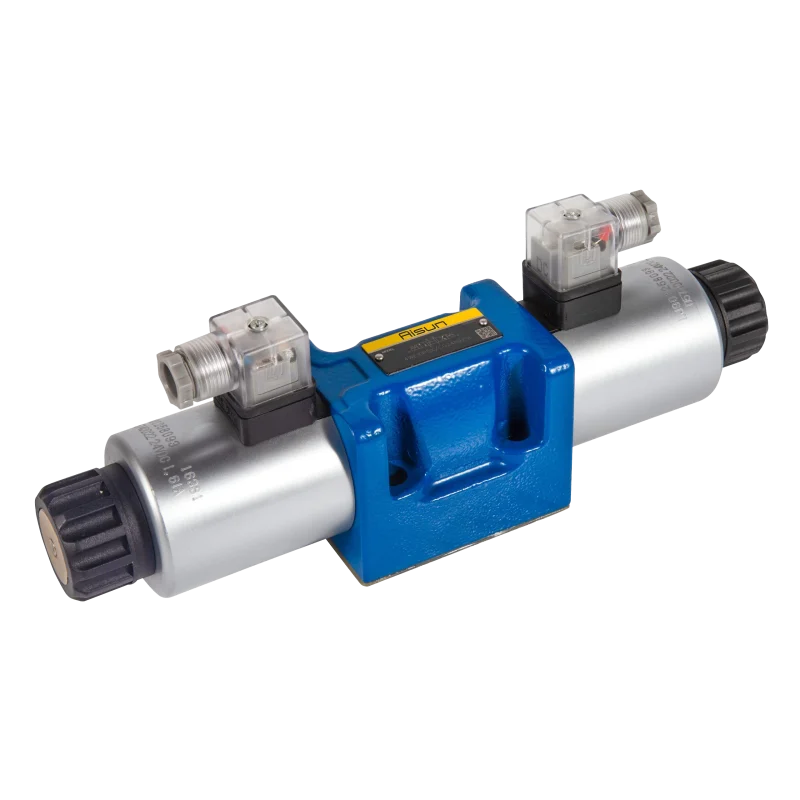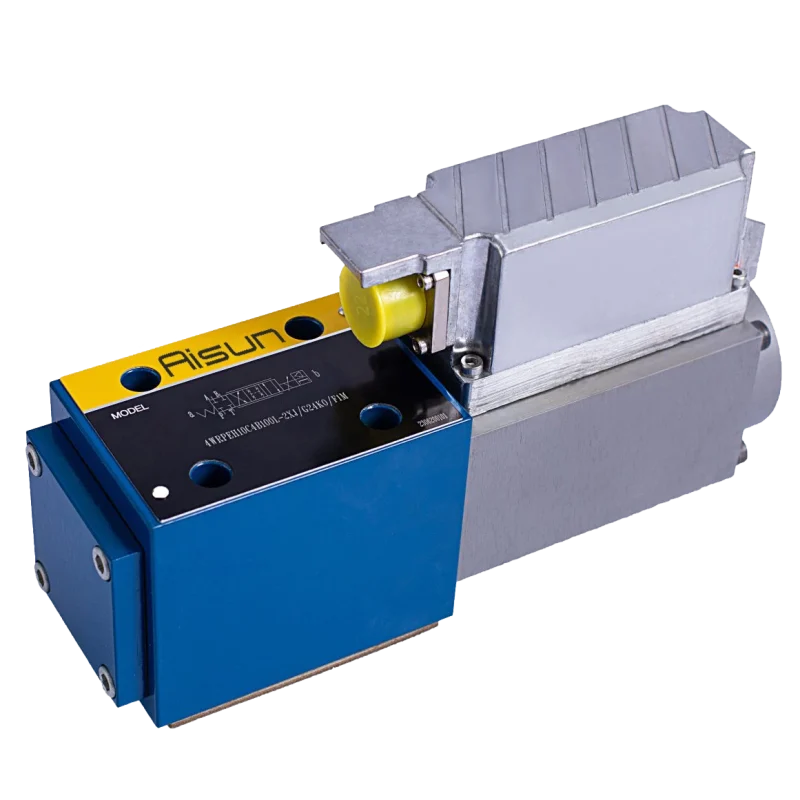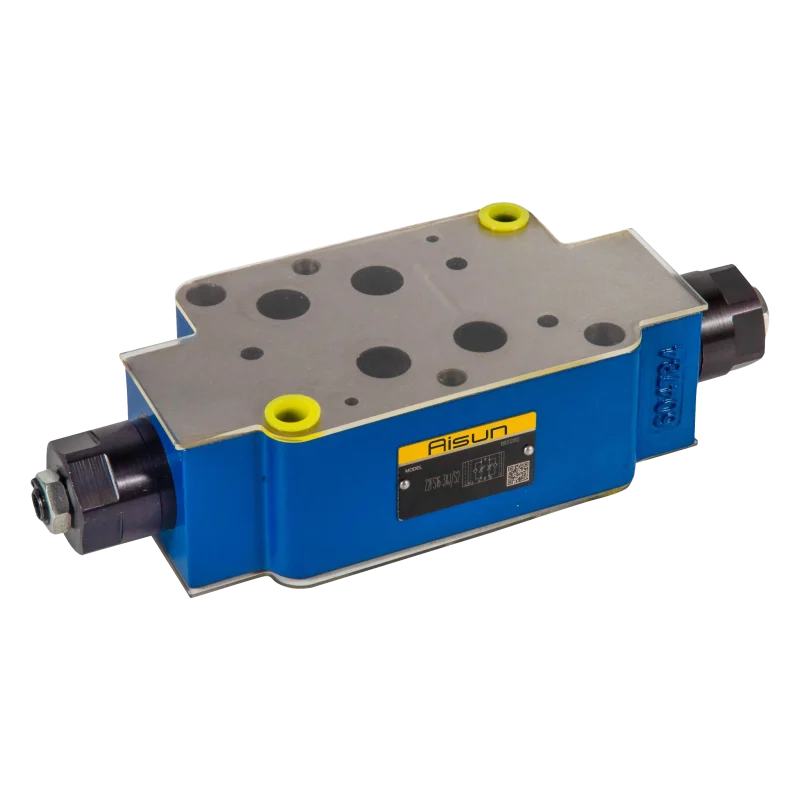M-SEW directional poppet valve
The M-SEW hydraulic directional poppet valve is a type of directional control valve commonly used in hydraulic systems to control the flow of fluid in a specific direction, thus controlling the movement and operation of hydraulic actuators like cylinders and motors.
Operation of the M-SEW Hydraulic Directional Poppet Valve:
The M-SEW valve is a poppet-type valve, which means it uses a poppet (a disk or ball) and a seat to control the flow of fluid. The valve can either direct fluid to different ports based on the position of the spool or poppet, depending on how it’s actuated. The primary function of the M-SEW directional poppet valve is to manage the direction of hydraulic fluid flow within the system, allowing it to flow toward specific actuators or components.
Here is a breakdown of how the M-SEW directional poppet valve works:
- Basic Design Components:
– Poppet: The poppet is the primary moving component inside the valve. It can either block or allow flow depending on its position relative to the valve seat.
– Spring: A spring often applies force on the poppet to keep it in a specific position (either open or closed), controlling the flow direction.
– Valve Seat: The seat is where the poppet rests when it is closed, ensuring tight sealing to prevent leakage when the valve is not allowing flow.
– Ports: The valve has several ports (inlet, outlet, and sometimes extra ports for additional directional control). These ports are connected to the hydraulic system, directing fluid as needed. - Valve Actuation:
The operation of the M-SEW hydraulic directional poppet valve depends on actuation. The valve can be actuated in several ways, including:
– Manual actuation: The valve can be controlled by a lever, knob, or pedal to shift the valve into the desired position.
– Electrical or pneumatic actuation: Some versions of the valve may use solenoids or pneumatic actuators to move the poppet. - Flow Direction Control:
The M-SEW valve can direct hydraulic fluid to different circuits depending on the position of the poppet. Here’s how the valve works in terms of fluid flow:
– Neutral Position (No Flow): When the valve is in its neutral position, the poppet is seated against the valve seat, blocking all flow. This prevents any fluid from passing through the valve, effectively stopping the movement of the hydraulic actuators.
– Flow to One Port (Active Position): When the valve is actuated (manually or electrically), the poppet moves away from the seat, allowing fluid to flow through the valve and reach the connected actuator (like a hydraulic cylinder or motor).
– Flow to Two Ports: In some configurations, the valve may allow fluid to flow to two different ports, either simultaneously or alternately, depending on the system requirements. This is common in valves with multiple positions (such as 2-way or 3-way valves), where fluid can be directed to different paths based on the valve’s position.
- Poppet and Spring Mechanism:
– The spring ensures that the poppet stays in its default position (often the neutral position) when no external force is applied. This is especially important for fail-safe operation in case of power loss or malfunction.
– The spring tension can be adjusted in some versions to change the pressure required to move the poppet, which can affect the overall system pressure and flow characteristics.
– The poppet can also have a sealing surface that is designed to tightly seal the valve when closed, preventing any leakage and ensuring that no fluid flows where it shouldn’t. - Modes of Operation:
The M-SEW directional poppet valve typically has several key operational modes, including:
– Spring Return: After actuation, the spring automatically returns the poppet to the neutral position when the external force (such as hydraulic pressure or manual actuation) is removed.
– Detent or Locking Mechanism: In some variants, the valve may include a detent mechanism that locks the valve in place, keeping it in the selected position (either for forward or reverse flow) until an external force is applied to shift it.
– Shifting Based on Pressure: The poppet can also be designed to shift under a specific pressure, opening up the flow path when the system reaches a certain threshold.
- Typical Port Configurations:
– 2-Way (Single Direction): The valve may have two ports, one for inlet and one for outlet, with the poppet either opening or closing based on flow direction.
– 3-Way (Bidirectional Flow): The M-SEW valve can also have three ports (one inlet and two outlets), directing fluid to one of two paths depending on the position of the poppet.
– 4-Way: In more complex systems, the valve can have four ports, directing fluid to one of four possible paths based on the valve’s position. - Common Use Cases:
– Actuator Control: The M-SEW valve is often used in hydraulic systems to control the direction of fluid to actuators like hydraulic cylinders or motors, ensuring they move in the desired direction.
– Power Take-Off (PTO) Systems: In mobile applications, the valve might be used to control the PTO, directing fluid to power machinery or other components.
– Load Control: The valve can help direct fluid to load-holding valves, allowing operators to manage the movement of a load in lifting or pressurizing applications.
Advantages of M-SEW Hydraulic Directional Poppet Valves:
1. Precise Flow Control: The poppet design ensures tight sealing, which results in precise control over fluid flow and efficient operation of hydraulic actuators.
2. Fail-Safe Operation: The spring-loaded mechanism allows the valve to return to a neutral position if no external forces are applied, preventing unintended fluid flow and maintaining system safety.
3. Versatility: The M-SEW valve can be used in various configurations (2-way, 3-way, 4-way) and is suitable for a wide range of industrial, mobile, and construction applications.
4. Reliability: The poppet valve design is robust and can withstand high pressures and flow rates, ensuring long-term reliability in demanding environments.
5. Simple Design: The design of the M-SEW valve is relatively simple and compact, which allows for easier integration into hydraulic systems without needing complex control mechanisms.
Solenoid Poppet Valve M-SEW
Solenoid Poppet Valve M-SEW
One of the primary advantages of the M-SEW directional Poppet valve is its ability to provide precise and rapid control over fluid flow. This is achieved through the integration of a highly responsive solenoid, which generates a magnetic field to actuate the valve mechanism. The solenoid converts electrical energy into mechanical force, allowing for the precise movement of the valve’s closing element. As a result, the M-SEW directional Poppet valve can effectively regulate fluid flow rates, enabling smooth and efficient operation of hydraulic systems.
Furthermore, the M-SEW valve exhibits exceptional durability and reliability. Constructed with high-quality materials and designed with meticulous engineering, this valve can withstand harsh operating conditions, including high pressure and temperature environments. Its robust construction ensures long-lasting performance, minimizing downtime and maintenance costs in industrial applications.





